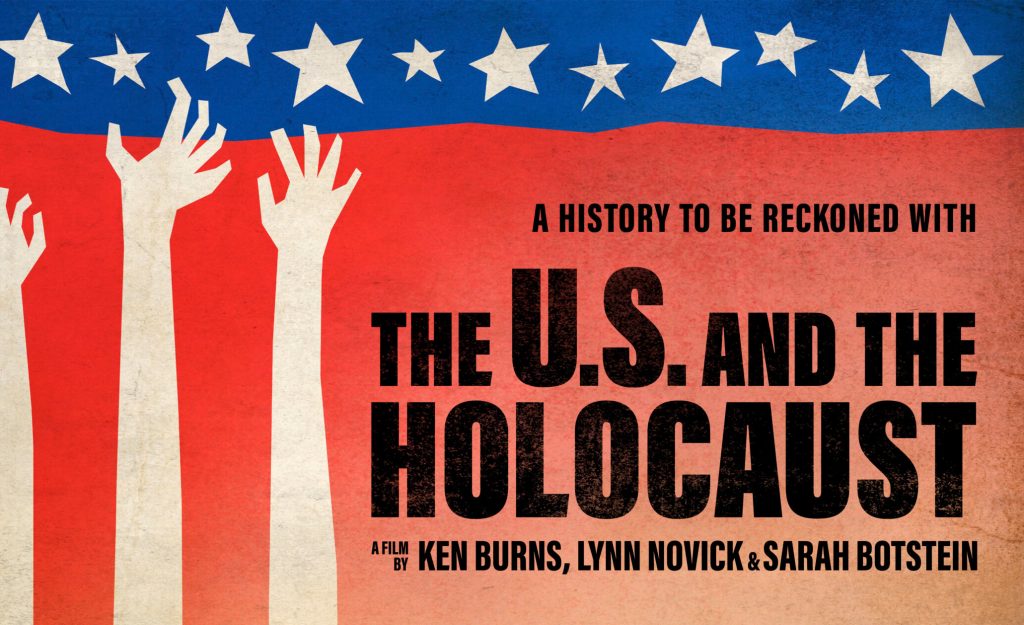

Bar none, Ken Burns (b. 1953) is decidedly America’s most important documentary filmmaker, notable as well for his multi-episode contributions exploring facets of this nation’s history and story His latest contribution—The U.S. and the Holocaust [2022; 3]—is no exception, and, as he himself has acknowledged in more than one interview, builds upon his 2014 The Roosevelts where the Holocaust/Shoah played only a relatively minor role, but one which he readily has also acknowledged may yet prove to be the “most important” thing he has done to date.
Intriguingly, he begins his six-hour video epic not with the 20th century, the rise of Nazism in Europe, America’s military entrance into World War II after the Japanese bombing of Pearl Harbor, Hawaii (7 December 1941), the incarceration of Japanese Americans in “concentration camps” in California and elsewhere, though all are both referenced and shown as part of the film’s sequences.
Uncomfortably, however, he begins in the previous century and dramatically and quite graphically shows that immigrant obstructionism is part and parcel of the American history and story—witness the obvious exclusion of Chinese immigrants and congressional legislative exclusion in the 19th century as well as Eastern European exclusion early in the 20th century—fueled by a growing isolationism and further hampered by the Great Depression of (1929-1939) prior to the onset of World War II. He also shows that antisemitism—simply put, hatred of the Jews and Judaism—has its own dishonorable history in the United States, and thus played a major role in America’s slow to non-existent efforts to aid the Jewish victims of the Nazi annihilationist agenda even after that agenda was both known and confirmed by those in positions of power, both military (e.g., refusing to bomb the railroad track to the Auschwitz death camp in southeastern Poland as questionably delaying the outcome of the war, defeating the Nazis) and governmentally (refusing specifically to increase and expand the quota of permitted Jewish refugees from war-torn Europe between 1939 and 1945).
Late Professor of History, University of Massachusetts, David Wyman (1929-2018), son and grandson of Protestant ministers, wrote two important texts, both documenting and affirming that, at no point during the Second World War, was the American European immigration quota filled higher than 20%! (Paper Walls: America and the Refugee Crisis, 1938-1941 (Amherst: The University of Massachusetts Press, 1968), and the more well-known The Abandonment of the Jews: America and the Holocaust 1941-1945 (New York: Pantheon Books, 1984). As Burns clearly shows, the primary, but not only, State Department obstructionist was Breckenridge Long (1881-1958), longtime friend and supporter of President Franklin Roosevelt (1882-1945) who served the latter’s administration as Under Secretary of State and Head of the Visa Division, and someone whose own antisemitism was transparent and whose comeuppance was the result of an initiative by members of the Treasury Department staff under its Secretary Henry Morgenthau, Jr., (1891-1967).
Long’s downfall would ultimately come from Morgenthau presenting FDR with his “Report to the President” which he had delicately retitled from its original and thoroughly documented “Report to the Secretary on the Acquiescence of This Government in the Murder of the Jews”. And, according to Morgenthau himself, FDR was unwilling to read the Report, preferring instead to have a conversation with Morgenthau before taking decisive action later which led to the formation of the War Refugee Board in January 1944—too little; too late. (Steven Leonard Jacobs (2010), “Obstructionism as Paradigm: The Case of Breckenridge Long”, in Nancy Rupprecht and Wendy Koenig, eds., The Holocaust and World War II: In History and Memory (Cambridge: Cambridge Scholars Press), 83-98; Rebecca Erbelding, Rescue Board: The Untold Story of America’s Efforts to Save the Jews of Europe [New York: Anchor Books, 2019].)
This issue of immigrant obstructionism has resonance for this author as regards the ultimate and tragic fate of my own grandparents (Ella and Leo Jacob, murdered in the Treblinka Vernichtungslager/Death Camp, July 1942). On 25 April 1940, one Paul T. Jackson., Superintendent of the Chemawa Indian School, Chemawa, OR—where my late father Ralph Albert Jacobs (1921-1981) was taken upon his arrival on these shores to avoid his telling what he had seen and experienced in Nazi Germany before his escape— received a letter from one A. M. Warren, Chief of the Visa Division, Department of State, Washington, DC. Dated 19 April 1940, it reads in part:
Since the Department and its representatives abroad are unable to undertake inquiries regarding the whereabouts and welfare of persons who are not American citizens, it appears that Mr. Jacob’s possible interment by the German authorities is a matter lying solely between him and German government.
The Embassy in Berlin denied my grandparents Visas to the US along with hundreds and possibly thousands of others, directly the result of Long’s memos instructing his overseas staff to do everything they could to “slow down” the immigration process. (Leo and Ella would later be transported from their home village of Zerbst, Anhalt, Lower Saxony, to the Warsaw Ghetto because of his original Polish birth and citizenship, and from there to Treblinka.) Today, two stolpersteine (footstones) have been place in the town of Zerbst by German artist Gunter Demnig (b. 1947) to honor my grandparents’ memories. Their small pictures, which my late father carried with him hidden in the soles of his shoes and which made it to the US, are now at home in my study there. (Steven Leonard Jacobs (1992), “Letters from Zerbst”, in Jan Colijn and Marcia Sachs Littell, eds., The Netherlands and Nazi Genocide: Papers from the 21st Annual Scholars Conference (Lewiston: the Edwin Mellen Press), 505-518.)
Finally, I, for one, am most appreciative of Ken Burns and his associates for sharing this darker side of the story of America’s involvement and/or lack thereof regarding the fate of the Jews during the Second World War and the tragedy of the Holocaust/Shoah. (See, for example, Rafael Medoff, America and the Holocaust: A Documentary History [Philadelphia: The Jewish Publication Society, 2022]; Daniel Greene and Edward Phillips, eds., Americans and the Holocaust [New Brunswick and London: Rutgers University Press, 2022]; Kathleen R. Arnold, ed., Anti-Immigration in the United States: A Historical Encyclopedia [Westport: Greenwood Press, 2011, 2 Volumes),
On an ending note, however, if one visits the United States Holocaust Memorial Museum in Washington, DC, and/or views this six-hour documentary, but bring to neither or both little foreknowledge of what actually transpired, one might falsely arrive at an incomplete understanding that this country was the true and major hero of the Second World War (e.g., both the British and the Soviet liberated the Nazi camps earlier than we did). Our own history of this period is far more complicated and far messier than what many of us were taught earlier in our educational journeys. Accurate knowledge remains the best antidote to both historical incompleteness and a massaging of our past. More so when the issues surrounding immigration to and into this country have yet to be resolved.
* The title of this piece is said to be the response of an unknown/unnamed Canadian immigration official when asked how many Jewish refugees Canada should let in during the Holocaust/Shoah of the Second World War. During that period, Canada admitted only 5,000 Jews, and afterwards—between 1945 and 1948—only 8,000 more. Irving Abella and Harold Troper, None is Too Many: Canada and the Jews of Europe 1933-1948 [New York: Random House 1983].)





More Stories
Originalism is not Original
2023 American Examples Call for Participants
A Feature of the System of Governance